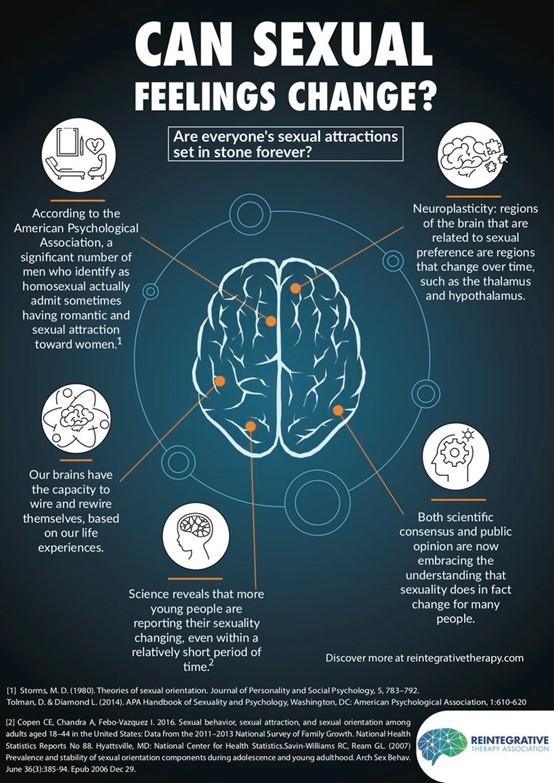https://www.reintegrativetherapy.com/the-science
創傷治療是目標。性傾向改變往往是附帶結果
Trauma Treatment is the Goal. Sexuality change is often the byproduct.
我們從大規模的縱向證據【1】中知道,整合式治療®(Reintegrative Therapy)與同性吸引(same-sex attractions)在統計上的顯著減少,異性吸引(heterosexual attractions)的增加,性別認同向異性戀身份改變以及心理健康增強(例如,焦慮,抑鬱和自殺傾向的減少)有關。

但是,為什麼性傾向改變(sexuality change)是創傷治療自發性的附帶結果呢?這可能是多種因素的結果。
自發性的性傾向改變機制

幾十年的科學已經表明,性傾向(sexuality)是流動性的,對某些人來說可以改變。我們知道大腦有能力根據我們的生活經驗來連接和重新連接自己。
根據美國心理學協會(American Psychological Association)【2】以及其他已發表的科學來源【3】,大量認同自己為同性戀的男性其實承認有時對女性會產生浪漫和性吸引的感覺。
美國心理學協會(APA)得出的結論是,經過30年對記錄在案的童年性虐待案例進行縱向研究的調查【4】,對於某些人來說,童年性虐待在某些情況下與擁有同性伴侶存在「關聯性和潛在的因果關係」。對於某些人來說,創傷經歷會隨後影響到性傾向【5,6】,而且童年創傷記憶的治療已被證明會引發顯著的性吸引自發性改變【7】。
整合式治療師有時將雙邊眼球運動納入創傷治療,這種方式已被證明可以引發委託人性傾向感覺(sexual feelings)的自發性改變,無論委託人的性別或性傾向如何【7,8,9】。整合式治療師有時會結合一種稱為「正念」(mindfulness)的實操訓練,也被證明可以引發性傾向感覺的自發性改變作為附帶結果【10】。在這些方法中,沒有一種會鼓勵委託人試圖改變他或她的性傾向感覺—事實上,試圖改變一個人的性傾向感覺實際上可能會干擾這個過程。這些記錄在案的性傾向改變機制是完全非意志性的(non-volitional)。
應該指出的是,美國心理學協會的道德原則第五原則(Principle E)保護委託人的自我決定權【11】,目標在於增強委託人的自主性。限制或干擾委託人的自主性違反了這一基本原則。整合式治療師尊重委託人設定自己的治療目標的權利,並有權獲得以證據為基礎的創傷解決方法,這些方法已被證明會引發自發性的性傾向改變作為附帶結果—這種特性(此外還有別的原因)就解釋了為什麼整合式治療不能被歸類為所謂的「性傾向轉變療法」(conversion therapy)。
如果有興趣回顧100多年的經驗證據,臨床研究和調查,表明一些男性和女性有可能隨著性傾向流動性幅度範圍發生偏移,並且改變(性傾向)的努力通常不會造成傷害,請按一下下面的深度總結。
了解更多資訊
引文:
[1] Pela, C., & Sutton, P. M. (2021) Sexual Attraction Fluidity and Well-Being in Men: A Therapeutic Outcome Study. Journal of Human Sexuality, 12 61-86.
[2] Storms, M. D. (1980). Theories of sexual orientation. Journal of Personality and Social Psychology, 38, 783–792. doi:10.1037/0022-3514.38.5.783.
[3] Vrangalova, Z., & Savin-Williams, R. C. (2012). Mostly heterosexual and mostly gay/lesbian: evidence for new sexual orientation identities. Archives of sexual behavior, 41(1), 85–101.
[4] Mustaky, B., Kuper, L., and Geene, G. (2014). Chapter 19: Development of sexual orientation and identity. In Tolman, D., & Diamond, L., Co-Editors-in-Chief (2014). APA Handbook of Sexuality and Psychology. Washington D.C.: American Psychological Association, 1 :609-610. See also: Roberts, A., Glymour, M., & Koenen, K. (2014). Considering alternative explanations for the associations among childhood adversity, childhood abuse, and adult sexual orientation: Reply to Bailey and Bailey (2013) and Rind (2013), Archives of Sexual Behavior 43:191-196.
[5] Padmal De Silva (2001) Impact of trauma on sexual functioning and sexual relationships, Sexual and Relationship Therapy,16:3, 269-278, DOI: 10.1080/14681990123900
[6] Parent, M.C., Ferriter, K.P. (2018) The Co-Occurrence of Asexuality and Self-Reported Post-Traumatic Stress Disorder Diagnosis and Sexual Trauma Within the Past 12 Months Among U.S. College Students. Archives of Sexual Behavior, May;47(4):1277-1282.
[7] Cornine, C.K. (2013). EMDR, Sexual Confusion, and God-Image: A Case Study. Journal of Psychology and Christianity, 32, 83.
[8] Bartels, RM Harkins L. Harrison, SC Beard, N. Beech AR. (2018) The effect of bilateral eye-movements versus no eye-movements on sexual fantasies. J Behav Ther Exp Psychiatry. 2018 Jun;59:107-114. doi: 10.1016/j.jbtep.2018.01.001. Epub 2018 Jan 4.
[9] F. Jebelli, M. Maaroufi, M. R. Maracy & M. Molaeinezhad (2018) Effectiveness of eye movement desensitization and reprocessing (EMDR) on the sexual function of Iranian women with lifelong vaginismus, Sexual and Relationship Therapy, 33:3, 325-338, DOI: 10.1080/14681994.2017.1323075
[10] Dickenson, Janna & Diamond, Lisa & King, Jace & Jenson, Kay & Anderson, Jeffrey. (2020). Understanding Heterosexual Women's Erotic Flexibility: the Role of Attention in Sexual Evaluations and Neural Responses to Sexual Stimuli. Social cognitive and affective neuroscience. 15. 10.1093/scan/nsaa058.
[11] https://www.apa.org/monitor/jun04/ethics
在某些情況下,童年性虐待與性吸引或行為有關:
Laumann et al, 1994; Tomeo, Templer, Anderson, & Kotler, 2001; Paul, Catania, Pollack, & Stall, 2001; Corliss, Cochran & Mays, 2002; Purcell, Malow, Dolezal, 2004, & Carballo-Dieguez, 2004; Bickham et al. 2007; Wilson & Widom, 2010; Friedman et al., 2011; Outlaw et al., 2011; Rothman, Exner, & Baughman, 2011, p. 328; Zietsch, 2011, in Uehara (Ed.), Psychiatric Disorders: Worldwide Advances; Hoffman, 2012; Sweet & Wells, 2012; McLaughlin, Hatzenbuehler, Xuan, & Conron, 2012; Andersen & Blosnich, 2013; Beard et al. 2013; Cooper et al., 2013; Artime, McCaloum, & Peterson, 2014; Mustanski, Kuper, and Greene (2014), in APA Handbook of Sexuality and Psychology 1:609-610; O’Keefe et al. 2014, p. 27; Brown, Masho, Perera, Mezuk, & Cohen, 2015; Xu & Zheng, 2015; Baams, 2018.

